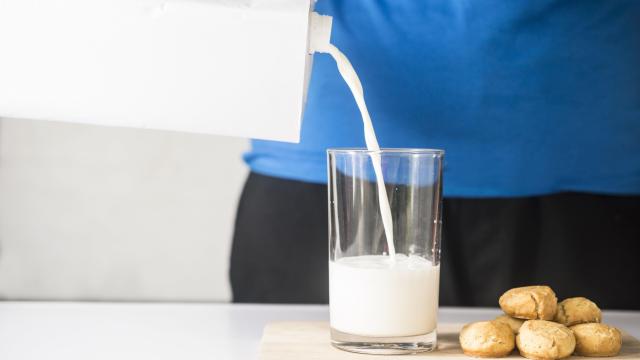Some completely expected, ordinary messes really piss me off. I think it’s because I’m fully aware that the mess is about to begin. Specifically, every time I open a new carton of almond milk and pour from the carton, it glugs. It glugs and it plops, and the milk splashes onto the counter for me to clean up. Luckily, there’s an easy fix for this, and it’ll forever change the way you pour liquids. Flip the direction you pour out of the carton.
Holding a carton of liquid so the spout is closest to the cup is a natural instinct. Often there’s a handle involved that further convinces you to hold it this particular way. You hold the spout to pour off the short cliff of the carton, so the stream has only one place to go. Then suddenly the “glug” is triggered and the liquid comes out in spurts and sputters.
When cartons and jugs are full of liquid, a light incline is enough to flood the small opening. It’s literally a bottleneck effect. The spout allows for a certain capacity of liquid to flow out while also allowing air in to replace it. The weight and force of a large amount of liquid blocks up the spout pretty quickly at the angle you’d need to pour it into a glass and not dribble it down the side, and the air can’t easily flow in to replace the liquid. Some of the liquid flows out and the pressure shifts, a bubble of air flows into the carton, the two processes repeat, and the liquid glugs again.
If you flip the carton and pour it off of the higher cliff, you give most of the liquid a reservoir to relax in while only a small amount of liquid inches toward the opening, lessening the demand on the carton’s spout. This gives you more control, and a consistent avenue for the air to come in above the stream, resulting in a smooth, glug-less pour. Many cartons have a tall seam sticking out of the top, blocking the pour from that angle, but don’t let that stop you. You can fold the paper seam down, or you can pour sideways (the third, medium-distance cliff, if you will). It’s really just that short one you should avoid until you’ve used enough of the liquid where the amount remaining and the angle of pouring reach a controllable balance of pressure.
This is great for drinks in jugs or liquid eggs in cartons, but also useful for harsh liquids and chemicals in similar packaging. I found this helpful for decanting coolant, motor oil, or bleach with precision. (Those are messes you don’t want to deal with.) Even though it might seem odd at first, give the carton flip a try. Pour safely out there.

Leave a Reply
You must be logged in to post a comment.